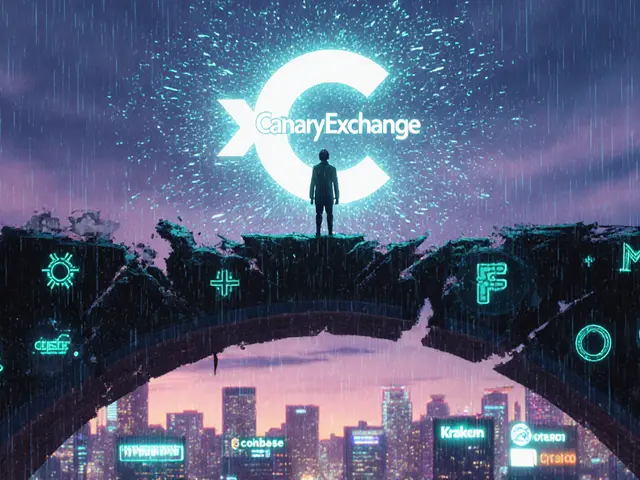Quick Takeaways
- Terrabit is listed as an untracked exchange on CoinMarketCap, meaning its trading volume isn’t verified.
- No public security documentation - no 2FA, cold storage, or bug‑bounty program evidence.
- Regulatory compliance is unclear; the platform does not appear to meet IOSCO or MiCA standards.
- Community chatter is virtually non‑existent, indicating very low adoption.
- Compared with Binance and Kraken, Terrabit falls short on transparency, security, and liquidity.
If you’ve typed “Terrabit crypto exchange review” into Google, you’re probably trying to decide whether to trust a platform that barely shows up in mainstream reports. Below you’ll find a no‑fluff breakdown of what Terrabit claims to be, what the data (or lack thereof) actually says, and how it stacks up against the industry heavyweights.
What Is Terrabit?
Terrabit is a cryptocurrency exchange that also markets itself as a payment processor and a mining application. The platform appears on CoinMarketCap with a status of “untracked,” meaning it either does not disclose its trading volume or fails the verification checks used by data aggregators.
How Terrabit Says It Works
The website advertises three core functions:
- Spot trading of major coins and a handful of low‑volume tokens.
- Integrated crypto‑payment gateway for merchants.
- Built‑in mining pool access for users who want to mine directly from the platform.
Unlike established players, Terrabit provides no whitepaper, no public road‑map, and no leadership bios. The absence of these basics makes it hard to verify whether the service is even operational or merely a placeholder site.
Transparency and Volume Reporting
Transparency is the bedrock of a trustworthy exchange. Platforms such as Binance and Coinbase publish daily volume figures that are cross‑checked by CoinMarketCap, CoinGecko, and independent auditors. Terrabit’s “untracked” label tells a different story: there is no reliable on‑chain or off‑chain data to confirm how much is actually being traded.
Why does this matter? In 2024, the crypto market lost $1.34 billion to ransomware and exchange hacks (Chainalysis, 2025). Regulators responded by demanding real‑time reporting to spot manipulation. An exchange that cannot be measured is automatically higher risk.
Security Measures - What’s Missing?
When you log into a reputable exchange, you expect at least two of these safeguards:
- Two‑factor authentication (preferably app‑based, not SMS).
- Cold‑storage of the majority of user funds.
- Regular security audits and a public bug‑bounty program.
- FIDO2‑compatible hardware security keys.
Searches of security‑focused publications (Arkose Labs, Chainalysis, and the IOSCO policy papers) reveal no mention of Terrabit implementing any of the above. By contrast, Kraken publicly documents cold‑storage ratios, API permission controls, and a bug‑bounty program worth up to $250 k.
In a world where a single SIM‑swap can drain a wallet, the lack of documented 2FA is a red flag. Without independent audits, you have no way to verify that private keys are encrypted or that transaction signing is secure.
Regulatory Landscape
Since the Bybit hack in February 2025, regulators across the US, EU, and Asia have tightened rules. The US GENIUS Act (July 2025) demands “strict cybersecurity protocols” for any exchange handling US customers. The EU’s MiCA framework (effective August 2025) requires clear disclosures, AML/KYC compliance, and regular reporting to supervisory authorities.
Terrabit does not appear on any “registered exchange” list maintained by the SEC, FCA, or ESMA. Moreover, there is no public evidence that it follows IOSCO’s 18 policy recommendations-particularly the sections on “substantive listing standards” and “market abuse prevention.” In short, the platform sits outside the emerging compliance bubble that many investors now consider a baseline.
Community and User Adoption
Even the smallest niche exchanges generate at least a handful of Reddit threads, Trustpilot reviews, or Telegram groups. A deep dive into Reddit, Trustpilot, and specialized forums turned up zero mentions of Terrabit. When a service has no user voice, you lose three critical data points:
- Liquidity - without traders, spreads widen and slippage spikes.
- Support - unanswered tickets can stall withdrawals.
- Real‑world testing - you can’t verify the “payment gateway” claim without merchants speaking about it.
Contrast that with Binance’s active community of millions and Kraken’s extensive help centre. The silence around Terrabit suggests either a brand-new launch that hasn’t attracted users yet or an essentially dormant platform.
Side‑by‑Side Comparison
| Attribute | Terrabit | Binance | Kraken |
|---|---|---|---|
| Volume Transparency | Untracked (no verification) | Verified daily on multiple aggregators | Verified, audited weekly |
| 2FA Method | Not publicly documented | App‑based authenticator, SMS optional | FIDO2‑compatible app & hardware key |
| Cold Storage % | Undisclosed | ~80 % of funds | ~95 % of assets |
| Regulatory Compliance | Unknown, no public filings | Registered in multiple jurisdictions | MiCA‑ready, IOSCO‑aligned |
| User Community | Zero public mentions | Millions across forums & socials | Hundreds of thousands, active support |
| Additional Services | Payment gateway claim, mining pool | Futures, staking, launchpad | Futures, margin, staking, OTC |

Pros and Cons Checklist
- Pros
- Potentially lower fees (no public fee schedule to confirm).
- Combined exchange‑payment‑mining concept could appeal to niche traders.
- Cons
- Lack of volume verification raises liquidity concerns.
- No verifiable security features - higher hack risk.
- Regulatory gray area; may be barred in major jurisdictions.
- Zero community feedback - hard to gauge real‑world performance.
Should You Use Terrabit?
Short answer: proceed with extreme caution, and only if you’re willing to risk capital you can afford to lose. If you need a reliable gateway for business payments, a proven security posture, or access to deep liquidity, the safer bet is to stick with established exchanges that publish audits and comply with MiCA and IOSCO guidelines.
Bottom Line
Terrabit’s promise of an all‑in‑one exchange, payment processor, and mining service sounds attractive on paper. In practice, the platform offers no verifiable data, no public security roadmap, and no regulatory footing. When the crypto world is already riddled with hacks and tightening oversight, investing time-or money-into an untracked exchange is a gamble that most users should avoid.
Frequently Asked Questions
Is Terrabit a safe place to store crypto?
Based on publicly available information, Terrabit does not disclose any security measures such as two‑factor authentication, cold storage ratios, or independent audits. For most users, the lack of evidence makes the platform unsuitable for long‑term storage.
Can I use Terrabit for merchant payments?
Terrabit claims to offer a payment gateway, but there are no integration guides, case studies, or third‑party endorsements. Until such documentation appears, it’s risky to rely on it for business‑critical payments.
How does Terrabit’s trading volume compare to Binance?
Binance reports verified daily volumes that often exceed $10 billion. Terrabit is listed as “untracked,” meaning there is no reliable volume data. In effect, Binance’s liquidity dwarfs Terrabit’s, which appears negligible.
Does Terrabit comply with MiCA regulations?
MiCA requires exchanges to register, publish AML/KYC policies, and undergo regular reporting. Terrabit provides no public filings or registration details, suggesting it is not MiCA‑compliant at this time.
Where can I find user reviews of Terrabit?
A thorough search of Reddit, Trustpilot, and crypto forums turns up zero mentions. The lack of community feedback is itself a warning sign.



Marina Campenni
May 1, 2025 AT 21:13I understand why the lack of transparency is unsettling; the crypto space thrives on trust, and without verifiable data it’s hard to feel confident. That said, it’s worth noting that many new projects start small and improve over time, so a cautious approach is reasonable.
Irish Mae Lariosa
May 11, 2025 AT 03:27The review raises several points that merit deeper consideration, and I will address each in turn. First, the classification of Terrabit as an "untracked" exchange on CoinMarketCap is not merely a label; it signifies an absence of verifiable on‑chain or off‑chain volume data, which, in turn, hampers any assessment of liquidity. Second, the omission of standard security measures such as two‑factor authentication, cold‑storage ratios, and public audit reports is a critical red flag, particularly given the prevalence of exploits in 2024 and 2025. Third, regulatory compliance cannot be an afterthought; without registration in jurisdictions adhering to IOSCO or MiCA guidelines, the platform remains in a legal gray zone that could affect both user protection and asset recoverability. Fourth, the lack of community engagement-no Reddit threads, Trustpilot reviews, or Telegram groups-means that potential users have no peer‑generated insights or support channels, further diminishing confidence. Fifth, the promised integration of a payment gateway and mining pool remains unsubstantiated, as no third‑party endorsements or technical documentation have been released. Sixth, the comparison with established exchanges such as Binance and Kraken underscores a stark disparity in transparency, security, and liquidity, which cannot be ignored. Seventh, while the prospect of lower fees is enticing, fee structures that are not publicly disclosed introduce uncertainty regarding cost predictability. Eighth, any consideration of Terrabit for merchant payments is premature without evidence of real‑world implementation or case studies. Ninth, the platform’s silence regarding AML/KYC procedures suggests potential non‑compliance with evolving regulatory frameworks, which could expose users to unwanted scrutiny. Tenth, the absence of a whitepaper, leadership bios, or a public roadmap eliminates the usual avenues investors use to gauge long‑term viability. Eleventh, the broader market context-rising regulatory scrutiny and heightened security expectations-means that users are less tolerant of opaque services. Twelfth, the risk of capital loss is amplified when operating on a platform that lacks independent audits, leaving users without recourse in the event of a breach. Thirteenth, the potential for market manipulation increases when volume data is unverified, as regulators cannot monitor abnormal trading patterns effectively. Fourteenth, the overall user experience is likely to suffer without a robust support infrastructure, which is evident from the absence of documented support tickets or response times. Finally, for those seeking a dependable exchange, the prudent choice remains to engage with platforms that demonstrate clear governance, verified metrics, and proactive regulatory alignment.
Nick O'Connor
May 20, 2025 AT 09:40We see a clear pattern here, don’t we? The details provided are sparse, the security claims are unverified, and the community footprint is essentially nonexistent; this combination is rarely a sign of a healthy ecosystem.
Sara Stewart
May 29, 2025 AT 15:53Exactly, and from a tech‑ops perspective, the lack of documented APIs, no SDKs, and missing compliance attestations make integration a nightmare. In the fintech space we rely heavily on standards-OAuth, KYC pipelines, AML analytics-and without those, any partnership would be risky at best.
Laura Hoch
June 7, 2025 AT 22:07It’s fascinating how the void of data invites speculation; one could argue that the silence is a strategic veil, yet it also reflects a paucity of substantive progress. Still, I’m reminded of the philosophical adage: without evidence, belief is mere conjecture, and in finance that conjecture can be costly.
Hailey M.
June 17, 2025 AT 04:20Wow, this whole thing reads like a mystery novel, except the mystery is why anyone would trust a platform that hides its basics. 😒🤦♀️ Seriously, if you’re looking for drama, stick to movies; for crypto, stick to proven exchanges.
Schuyler Whetstone
June 26, 2025 AT 10:33Honestly, people who jump on unknown exchanges are just asking for trouble. It’s like leaving your front door wide open and wondering why strangers keep walking in. Get a real platform or learn to stay safe.
Pierce O'Donnell
July 5, 2025 AT 16:47Cool idea, but no hype.
Bobby Lind
July 14, 2025 AT 23:00Interesting point, and it reminds us that not every shiny new service is worth the risk; taking a measured approach can save us a lot of headaches later on.
Deepak Kumar
July 24, 2025 AT 05:13Let’s break this down constructively: first, the absence of 2FA and cold‑storage disclosures is a deal‑breaker for most security‑conscious users; second, the unverified volume suggests liquidity issues that could lead to slippage; third, lacking regulatory registration means potential legal exposure; finally, without a community you miss out on peer support and real‑world testing. For anyone considering Terrabit, I’d recommend exploring established alternatives that provide transparency, robust security protocols, and active user forums-these factors collectively lower risk and improve the overall trading experience.